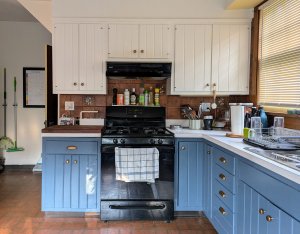

We may earn revenue from the products available on this page and participate in affiliate programs. Learn More ›

Ask the Team
Ask the Team is a series where we—the BobVila.com team—answer your questions. From questions about projects you need expert guidance on, to home maintenance tasks you’ve never tackled before, and everything in between, we’re here to lend a helping hand. Have a question? Email contact@bobvila.com and look out for answers in future installments of Ask the Team.
I have a patio table that is oxidized. What works good to brighten it up again? The metal color is brown. Thanks. —Steve F.
Steve, I’m betting that your brown metal table is aluminum—that’s been commonly used to make patio sets for decades because it’s weather-resistant and durable yet lightweight enough to reposition around your backyard. They’re known to be corrosion-resistant, but that’s not to say that they’re entirely maintenance-free. To remove the oxidation, try applying a mildly acidic solution of equal parts vinegar and water. Gently scrub with a sponge after a few minutes, then rinse and towel-dry. If that doesn’t do the trick, you might up the ante with a commercial aluminum cleaner, like that from Star Brite. —Kathleen Corlett, Editor-in-Chief
I welcomed the chance to get a chalk paint recipe from the Bob Vila site. However, I had a problem interpreting the recipe for using plaster of Paris. The [article] said that the ratio of paste of Paris to paint should be 1 to 3. Is that 1 part liquid plaster of Paris (after blending with water) to 3 parts paint, or 1 cup of dry plaster of Paris to 3 cups of paint? My daughter and I did chalk paint a few months ago and sealed it with urethane, and it peeled all over the place. I don’t want to repeat that error, whatever it was, again, if I can help it. —Mary Pat L.
Hi Mary! I’m so sorry to hear your chalk paint project peeled. That’s so disappointing after all that work. I think I can help keep that from happening again. For the recipe, start with a third of a cup of dry plaster of Paris powder and mix in 2 to 3 tablespoons of water, stirring until it forms a smooth, creamy paste. Then blend that paste into 1 cup of latex paint, stirring well until it’s smooth. That will give you the chalk paint you’re looking for. The peeling, however, was probably the result of using urethane as a sealer. Chalk paint is very porous, so instead of soaking in, oil-based urethane sits on top, and as it cures it can shrink and pull away, which causes flaking. Urethane also tends to yellow, which isn’t optimal for chalk paint’s flat, light finish. Next time, for your sealant, try a water-based polycrylic, like Minwax Polycrylic. It should bond much better and it remains clear. Happy painting! —Glenda Taylor, Staff Writer
Do you have any suggestions for getting rid of VOLES in my yard? They are multiplying and disrupting my landscaping. —Mary J.
Hello Mary. Our best advice for getting rid of voles in your landscape involves three main steps: making your yard less hospitable for them by cleaning up brush and fallen leaves; using natural repellents such as castor and capsaicin oils to drive them away; and fencing them out with critter mesh installed at least a foot deep since they are diggers. Doing these tasks first will not only help chase voles out of your yard, they will also help to prevent the pests from returning. You can learn more about each of these steps in our full how-to guide on getting rid of voles. —Jenny Stanley, Executive Editor
Hello. I just had a handyman install a small window AC in my bedroom. He didn’t install a bracket or caulk on the exterior. Should he have? Also, would it be good to have spray foam in addition to weatherstripping? —H.K.
Hi! Thanks for your question. Most window AC units work best when they’re supported and sealed, though some smaller models are designed to sit safely without a bracket. Since you didn’t mention the model, the best step is to check the manufacturer’s installation guide—it will say if a bracket is required. In almost every case, adding weatherstripping and a bead of exterior caulk along the sides and top helps improve efficiency and keeps out rain and pests. Foam isn’t ideal since it cures permanently and can be tough to remove; instead, products like DAP Seal ‘N Peel or rope caulk are easier to work with and will make the unit weathertight. —Glenda Taylor
Glenda Taylor’s DIY deck cleaner very effectively enabled me to clean a very dirty pressure-treated wood deck that had not been cleaned or sealed in at least 20 years. Thank you! Can I use the same solution to clean brownstone? I have a historic brownstone in Brooklyn that was re-brownstoned about 15 years ago. The brownstone, especially on the stoop and lower areas, is dirty and also has areas with green mold. Appreciate your help! —David G.
Hi David! I’m glad you had good luck with the deck cleaner recipe! However, since you want to clean a historic brownstone, I think I’d opt for a proven safe product, such as Cathedral Stone Product’s “Heavy Duty Cleaner”. This is a gentle but effective cleaner that will remove carbon staining, dirt, and grime, and I’ve used it successfully on the walls of a historic sandstone church. Best of luck! —Glenda Taylor
I have a shed roof pitch question: 1. The two front posts are 8 feet high. 2. The roof will slant down to the back two posts. 3. My desired roof pitch is 2 1/4 inches vertical to 12 inches horizontal. 4. The shed will be 8 feet from front to back. 5. I am estimating that the back two posts will each be 78 inches high. Is this correct? —Phil C.
Hi Phil! You are correct. If you want a 2 1/4-inch drop per foot, and from front to back it’s 8 feet (96 inches), your back posts will be 78 inches high. Just a quick note—that 2 1/4-inch drop is adequate for a mule hide type (peel-and-stick) product or metal roofing. If you’re going with shingles, you might consider using a double layer of 15-pound felt under the shingles to reduce the risk of leaks. And you might check the specs on the roofing material you use—most will give you a recommended type of underlayment based on the pitch of the roof. Happy building! —Glenda Taylor
